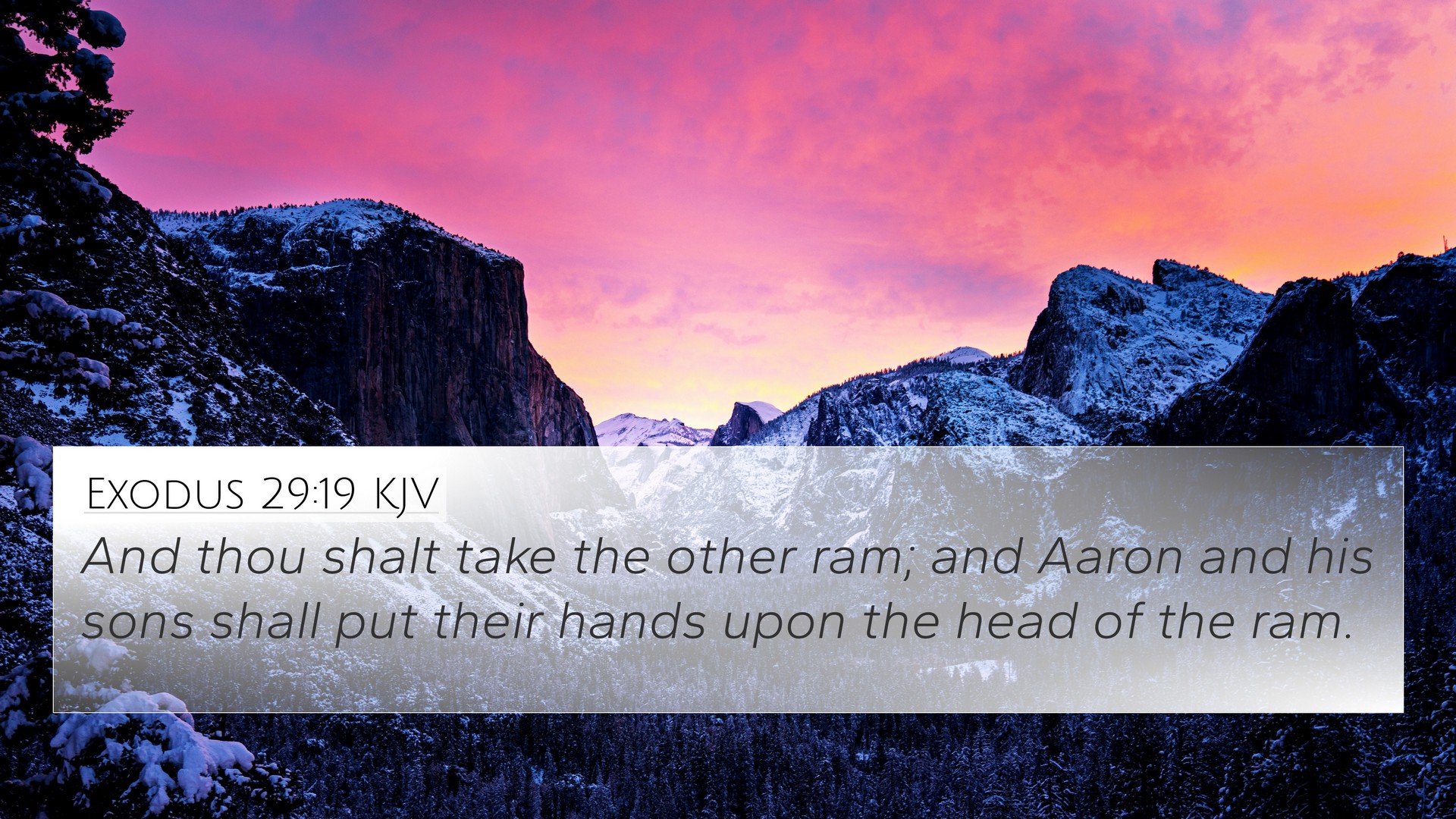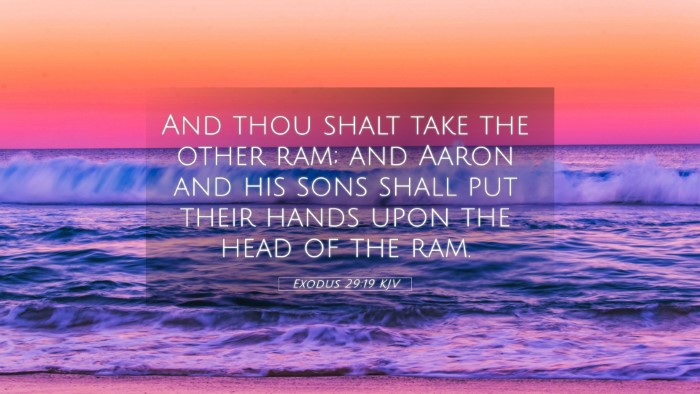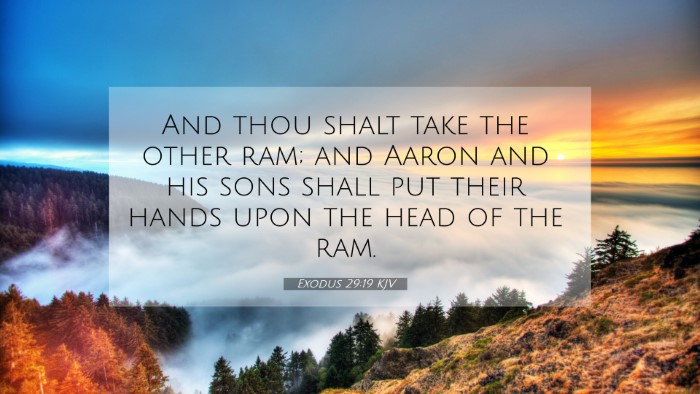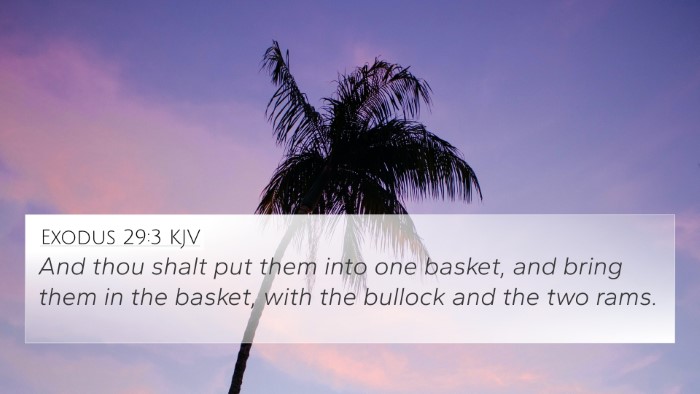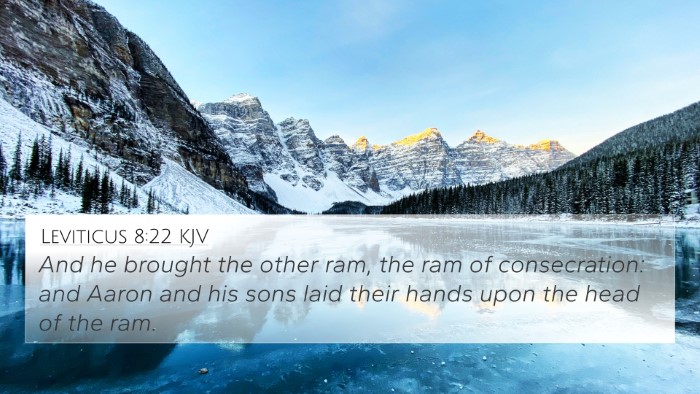Exodus 29:19 - Understanding the Significance of the Consecration of the Priesthood
Bible Verse: Exodus 29:19 - "And you shall take the other ram, and Aaron and his sons shall lay their hands on the head of the ram."
Meaning and Interpretation
The verse Exodus 29:19 is part of God’s instructions to Moses regarding the consecration of Aaron and his sons as priests. This particular act of laying hands on the ram was a pivotal moment in the ordination process, symbolizing the transfer of responsibility and the sin offering of the priests.
Key Insights from Public Domain Commentaries
-
Matthew Henry: Henry emphasizes that the laying on of hands was a way to signify the identification of the priests with the ram, as well as the accompanying transference of sin and guilt onto the animal, which would then be offered as a sacrifice. This act foreshadows the ultimate sacrifice made by Christ, highlighting the importance of atonement for service in God’s Kingdom.
-
Albert Barnes: Barnes elaborates on the ritual's significance in demonstrating the seriousness of the priesthood. He notes that it established a connection between the priests and the offerings they would present, indicating that their service was directly linked to the holiness of the offerings and, ultimately, to God Himself. The act was an essential display of submission and commitment to divine service.
-
Adam Clarke: Clarke points out the deeper theological implications of this ritual. He suggests that it represents a public acknowledgment of the priests' duties and the serious nature of their responsibility before God. Clarke also observes how this laid the groundwork for a sacrificial system that would underscore the need for holiness and atonement within the community of Israel.
Bible Cross-References Related to Exodus 29:19
- Leviticus 16:21 - The similar act of laying hands on a scapegoat, transferring the sins of Israel onto it.
- Hebrews 7:24-27 - The perfect priesthood of Christ compared to the Levitical priesthood; a reflection on perpetual sacrifice.
- 1 Peter 2:9 - The priesthood of believers, connecting New Testament teachings with the Old Testament priestly function.
- Romans 12:1 - The call for present-day believers to offer their bodies as living sacrifices, echoing the concept of consecration.
- Exodus 29:20 - Further instructions regarding the sacrifice and the significance of the blood, pointing back to the idea of atonement.
- Numbers 8:10-14 - The consecration of Levites with a similar emphasis on the priests' role and dedication to God.
- 2 Corinthians 5:21 - The doctrine of substitutionary atonement brought forth in Christ, drawing parallels to the sacrificial system established in Exodus.
Connections Between Bible Verses
This scripture invites a comprehensive analysis of the thread of atonement and priesthood throughout the Bible. By conducting a comparative Bible verse analysis, one can identify profound links between the Old Testament sacrificial system and New Testament teachings. Each cross-reference serves to deepen the understanding of God's redemptive plan.
Thematic Connections
- Consecration: The theme of consecration is prevalent in both the Old and New Testaments, emphasizing the need for purity and dedication to God's service.
- Atonement: The process of laying on hands and sacrificing a ram significantly illustrates the doctrine of atonement, later fulfilled through Christ.
- Priesthood: The transition from the Levitical priesthood to the priesthood of all believers demonstrates a continuity in God's plan for mediation between Him and humanity.
The Importance of Cross-ReferencingBible Texts
Engaging with the text of Exodus 29:19 through an inter-biblical dialogue reveals not only its significance in Israel’s worship practices but also its implications for understanding Jesus’ role as the ultimate High Priest. Tools for Bible cross-referencing, such as concordances and guides, can aid in exploring these meaningful connections.
Conclusion
Exodus 29:19 serves as a vital link in the narrative of Scripture, showcasing the importance of priestly ordination and the foreshadowing of Christ's sacrificial role. Through cross-referencing and thematic studies, one can uncover a rich tapestry of biblical truths that connect the ancient rituals to modern faith practices.
